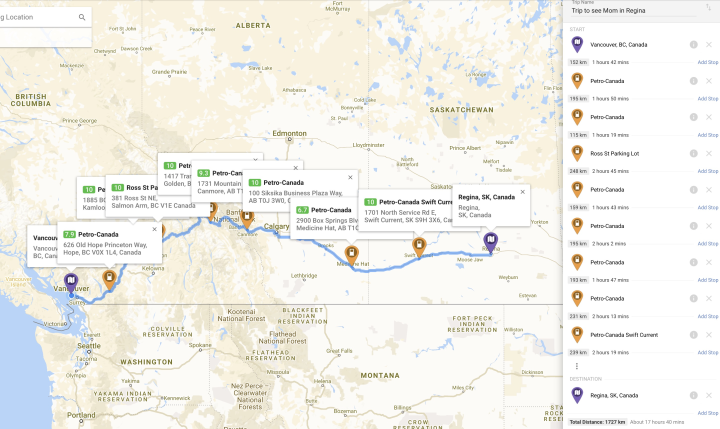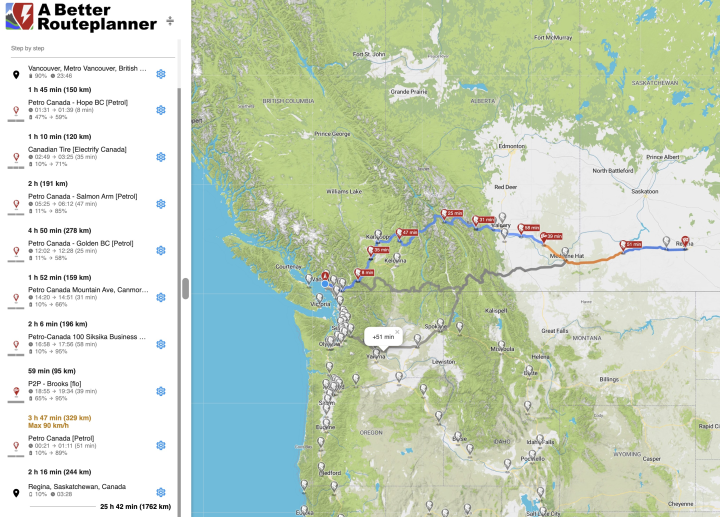
I haven’t seen my 90-year-old mother since January. I guess by mid-year both she and I are likely to be vaccinated so maybe I could go visit. I’d rather drive than fly. What with Covid I’ve been cooped up so long I could scream, so there are few things I’d rather do than get out on the highway. As a displacement activity I’ve been working out how I could get the electric Jaguar 1734 kilometres from Vancouver to Saskatchewan to see her. Thus this quick survey of the state of the infrastructure in Western Canada, and also trip-planning tools. Some of this info might be useful elsewhere.
Infrastructure · For this to make sense, you have to realize that while Canada looks like a big tall country on the map, it’s actually a short wide country, mostly cuddled up against the USA, nine thousand kilometres wide and with most people living 500km or less from the border. So for purposes of charging cars, if you have good coverage of Route 1, the Trans-Canada Highway, you’ve solved a big piece of the problem. My drive from Vancouver to Regina, Saskatchewan is along that road all the way.
Back when I got the Jag in January 2019, it’d have been generous to call the coverage spotty. The government of BC, the westernmost province, had scattered fast chargers here and there around the highways, but they were only 50kW (just barely “fast”) and the reliability was poor. Once you got out of BC and onto the Prairies, the story got worse fast.
Now there are two outfits trying to build out good cross-country coverage: Petro-Canada, the gas-station brand of Suncor, a biggish oil caompany, and Electrify Canada, an outgrowth of Electrify America, a subsidiary of Volkswagen that they launched in 2016 in the wake of their lying-about-emissions scandal to wave the green flag. The Electrify Canada chargers are located at Canadian Tire, an ubiquitous Canadian hardware store which specializes in automotive stuff.
Both networks have mobile apps to facilitate charging, and both charge a flat 27¢/minute. Which is a lot more expensive than the kWh I soak up from my Level-2 charger at home, but still plenty cheaper than gas.
It’s at least somewhat true that at this point both of these operations are aspirational, more of an attempt to make a point than make a buck. But EV sales are ramping and will ramp faster, so I think it’ll prove to have been a smart move.
Both operate modern chargers advertised as offering 200-350kW of juice. Some of the most recent cars, like the Porsche Taycan, are said to be able to make good use of that power and charge amazingly fast. My Jaguar I-Pace can only soak up 100kW and not for that long, it pretty quickly starts backing off. In an online I-Pace discussion group one guy said that at Petro-Canada, he went from 20% to 80% in 45 minutes, which I’d say is adequate, while another one said it took 52 minutes to get from 50% to 94%. These reports are consistent, because as far as I know all electric car charging slows down dramatically at about the 80% point. So it’s considered polite and efficient to charge up to 80% and then move along.
Tools · The networks have their own maps: Here’s Petro-Canada’s and here’s Electrify Canada’s. At the moment Petro-Canada is well ahead; Watch out though, their map includes chargers that are planned but not running yet.
If you want to plan a trip, I’ve run across two useful tools. First is PlugShare, which I’ve been pretty impressed with. You make an account and tell it what kind of car you have and apply filters to the kind of chargers you want to see — for the purposes of a trans-Canada trip, that means “Level 3” DC fast chargers only. Then it has tools to plan a trip — you have to pick chargers by hand and add them. It’ll export the results to Google Maps and do a bunch of other useful stuff. Here’s how it looks.
Watch out, this map and the other one are huge so you can read the small print; you might have to pan around to see them, particularly on a small laptop screen.
One nice thing about PlugShare is that it’s got a community thing going, you can click on any charger on the map and see reports from people who’ve charged up recently, on how to find it and how it’s working. There’s an average rating, that’s the little green number badge on each stop.
The other option is something called A Better Routeplanner (let’s say “ABRp”), which is a whole lot more automated and has significant pluses and minuses. By “automated” I mean you just put in your start and destination and it picks all the driving legs and charging stops. It picked almost exactly the same set that I picked by hand in PlugShare. First of all, here’s its map.
The readout is slicker, it estimates how much charge you’ll need and how long it’ll take at each stop. But there are problems. First of all, it recommends using the Petro-Canada charger in Salmon Arm, but when you click on that, the info-box says it isn’t actually operational yet (PlugShare agrees) — but there’s an older-fashioned 50kW charger there. Electrify Canada says theirs is coming soon too, so maybe it’ll be fast by the time we can travel again.
Now here’s the weird thing. ABRp will give you a URL for your route plan: here’s mine. If you click on that, it’ll take some time, apparently it recomputes the whole thing. What’s weird is that I get different maps in Chrome and Safari. In Chrome, it doesn’t seem to know about the Petro-Can charger in Medicine Hat — thus the orange-line route segment, where it’s telling me that I have to drive slow to conserve power.
Both PlugShare and ABRp have mobile apps that look OK at first glance.
Take-aways · The charging infrastructure in Western Canada is pretty good, or at least will be once they get Salmon Arm filled in. The planning tools are just fine. I can’t wait to get on the road this summer. And to see my Mom.
如有侵权请联系:admin#unsafe.sh

